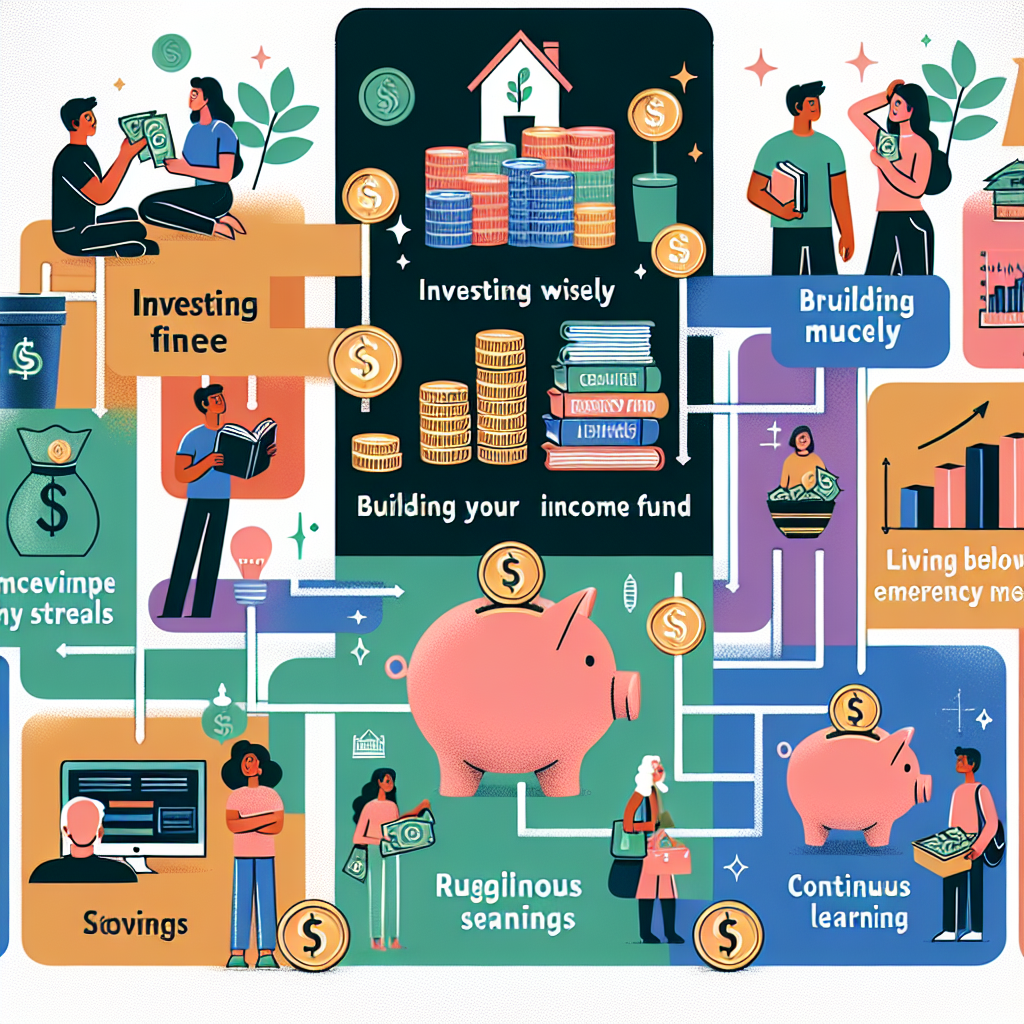
Smart Budgeting Strategies
Achieving financial independence early is a goal many aspire to, and smart budgeting strategies play a crucial role in making this dream a reality. To begin with, understanding your financial situation is the first step. This involves tracking your income and expenses meticulously. By doing so, you can identify areas where you might be overspending and opportunities to save more. For instance, you might discover that dining out frequently is draining your budget, prompting you to cook more meals at home.
Once you have a clear picture of your finances, setting realistic and achievable financial goals becomes essential. These goals should be specific, measurable, attainable, relevant, and time-bound (SMART). For example, instead of vaguely aiming to ”save more money,” you could set a goal to ”save $500 each month for the next year.” This clarity helps in maintaining focus and motivation.
Transitioning to the next strategy, creating a detailed budget is indispensable. A well-structured budget allocates funds for necessities, savings, and discretionary spending. One effective method is the 50/30/20 rule, where 50% of your income goes towards needs, 30% towards wants, and 20% towards savings and debt repayment. This approach ensures that you are not only covering your essential expenses but also setting aside money for future financial security.
Moreover, automating your savings can significantly enhance your budgeting efforts. By setting up automatic transfers to your savings account, you ensure that a portion of your income is saved before you even have the chance to spend it. This ”pay yourself first” strategy can help in building a substantial savings cushion over time without requiring constant effort.
In addition to saving, managing debt effectively is another critical aspect of smart budgeting. High-interest debt, such as credit card debt, can quickly erode your financial stability. Prioritizing debt repayment, especially for high-interest loans, can save you a considerable amount of money in the long run. Utilizing strategies like the debt snowball or debt avalanche methods can provide structured and efficient ways to tackle debt.
Furthermore, living below your means is a principle that cannot be overstated. This doesn’t necessarily mean living a frugal or deprived life but rather making conscious spending choices. For example, opting for a modest home or car that fits your needs rather than splurging on luxury items can free up significant funds for savings and investments.
Investing wisely is another cornerstone of achieving financial independence. While saving is crucial, investing allows your money to grow over time. Diversifying your investments across different asset classes, such as stocks, bonds, and real estate, can help in mitigating risks and maximizing returns. Additionally, taking advantage of tax-advantaged accounts like 401(k)s and IRAs can provide substantial tax benefits and accelerate your journey towards financial independence.
Lastly, continuously educating yourself about personal finance is vital. The financial landscape is ever-evolving, and staying informed about new strategies, tools, and opportunities can provide you with an edge. Reading books, attending workshops, and following reputable financial blogs can enhance your financial literacy and decision-making skills.
In conclusion, achieving financial independence early requires a combination of disciplined budgeting, strategic saving, prudent debt management, and informed investing. By implementing these smart budgeting strategies, you can pave the way towards a financially secure and independent future. Remember, the journey to financial independence is a marathon, not a sprint, and every small step you take today brings you closer to your ultimate goal.
Investing In Index Funds
Investing in index funds can be a powerful strategy for those aiming to achieve financial independence early. These funds, which track the performance of a specific market index, offer a simple yet effective way to grow your wealth over time. One of the primary advantages of index funds is their diversification. By investing in a broad range of companies, you spread your risk, which can help protect your investments from the volatility of individual stocks. This diversification is particularly beneficial for those who are new to investing or who prefer a more hands-off approach.
Moreover, index funds typically come with lower fees compared to actively managed funds. Since they simply mirror the performance of an index, there is no need for a team of analysts and managers, which significantly reduces the cost. These savings can add up over time, allowing more of your money to stay invested and grow. Additionally, the lower fees mean that you can start investing with smaller amounts, making it accessible for those just beginning their financial journey.
Another key benefit of index funds is their historical performance. While past performance is not a guarantee of future results, many index funds have consistently delivered solid returns over the long term. This makes them an attractive option for those looking to build wealth steadily and securely. By investing regularly, such as through a monthly contribution plan, you can take advantage of dollar-cost averaging. This strategy involves buying more shares when prices are low and fewer when prices are high, which can help smooth out the effects of market fluctuations.
Furthermore, index funds offer a level of simplicity that can be appealing to many investors. With so many investment options available, it can be overwhelming to decide where to put your money. Index funds eliminate much of this complexity by providing a straightforward, no-fuss way to invest. You don’t need to spend hours researching individual stocks or trying to time the market. Instead, you can set up automatic contributions and let your investments grow over time.
In addition to these benefits, index funds can also be a tax-efficient investment choice. Because they have lower turnover rates compared to actively managed funds, they tend to generate fewer capital gains distributions. This can result in lower tax liabilities, allowing you to keep more of your returns. For those aiming for early financial independence, minimizing taxes is a crucial aspect of maximizing your investment growth.
It’s also worth noting that index funds can be a versatile component of your overall investment strategy. They can serve as the foundation of your portfolio, providing stability and steady growth, while you explore other investment opportunities. For example, you might choose to allocate a portion of your portfolio to more aggressive investments, such as individual stocks or real estate, while keeping the bulk of your assets in index funds. This balanced approach can help you achieve your financial goals while managing risk effectively.
In conclusion, investing in index funds offers numerous advantages for those seeking to achieve financial independence early. Their diversification, low fees, historical performance, simplicity, tax efficiency, and versatility make them an excellent choice for building long-term wealth. By incorporating index funds into your investment strategy, you can set yourself on a path toward financial freedom, allowing you to enjoy the benefits of your hard work and smart investing decisions.
Reducing Unnecessary Expenses
Achieving financial independence early is a goal many aspire to, and one of the most effective strategies to reach this milestone is by reducing unnecessary expenses. By carefully examining your spending habits and making mindful adjustments, you can free up more money to save and invest, accelerating your journey toward financial freedom.
To begin with, it’s essential to differentiate between needs and wants. Needs are the essentials required for basic living, such as housing, food, and healthcare, while wants are non-essential items that enhance your lifestyle but are not crucial for survival. By focusing on your needs and minimizing spending on wants, you can significantly cut down on unnecessary expenses. For instance, instead of dining out frequently, consider cooking at home. Not only is it more cost-effective, but it also allows you to make healthier choices.
Another practical approach is to create a budget and stick to it. A well-structured budget helps you track your income and expenses, making it easier to identify areas where you can cut back. Start by listing all your monthly expenses and categorizing them into fixed and variable costs. Fixed costs, such as rent or mortgage payments, are generally non-negotiable, but variable costs, like entertainment and dining out, offer more flexibility. By setting limits on variable expenses, you can ensure that you are not overspending in these areas.
Moreover, it’s beneficial to review your subscriptions and memberships regularly. Many people sign up for services they rarely use, such as gym memberships, streaming services, or magazine subscriptions. Canceling or downgrading these can result in substantial savings over time. Additionally, consider sharing subscriptions with family or friends to split the cost, making it more affordable for everyone involved.
Shopping smartly is another key aspect of reducing unnecessary expenses. Before making a purchase, ask yourself if it is something you truly need or if it can wait. Taking a moment to reflect can prevent impulse buying, which often leads to regret and wasted money. Furthermore, take advantage of sales, discounts, and coupons whenever possible. Shopping during off-peak seasons or buying in bulk can also result in significant savings.
Transportation is another area where costs can quickly add up. If you own a car, consider whether you truly need it or if you can rely on public transportation, biking, or walking for your daily commute. Carpooling with colleagues or friends is another cost-effective alternative. If owning a car is necessary, ensure that you maintain it regularly to avoid costly repairs in the future and shop around for the best insurance rates.
Energy consumption is another often-overlooked area where you can save money. Simple changes, such as turning off lights when not in use, using energy-efficient appliances, and adjusting your thermostat, can lead to lower utility bills. Additionally, consider investing in renewable energy sources, such as solar panels, which can provide long-term savings and reduce your environmental footprint.
Lastly, cultivating a mindset of frugality and mindfulness can have a profound impact on your financial habits. By being conscious of your spending and prioritizing long-term goals over short-term gratification, you can make more informed financial decisions. Surround yourself with like-minded individuals who support your goals and can offer advice and encouragement along the way.
In conclusion, reducing unnecessary expenses is a crucial step toward achieving financial independence early. By distinguishing between needs and wants, creating and adhering to a budget, reviewing subscriptions, shopping smartly, optimizing transportation costs, and being mindful of energy consumption, you can free up more money to save and invest. With dedication and a strategic approach, financial independence can become a reality sooner than you might think.
Building Multiple Income Streams
Achieving financial independence early is a goal that many aspire to, and one of the most effective strategies to reach this milestone is by building multiple income streams. Diversifying your sources of income not only provides financial security but also accelerates your journey towards financial freedom. To begin with, it’s essential to understand that relying solely on a single source of income, such as a traditional 9-to-5 job, can be risky. Economic downturns, job losses, or unexpected expenses can quickly derail your financial plans. Therefore, creating multiple income streams can act as a safety net, ensuring that you have a steady flow of money even if one source dries up.
One of the first steps in building multiple income streams is to assess your skills and interests. By identifying what you are good at and what you enjoy doing, you can explore opportunities that align with your strengths. For instance, if you have a knack for writing, you could consider freelance writing or starting a blog. Similarly, if you have expertise in a particular field, you could offer consulting services or create online courses. The key is to leverage your existing skills to create additional revenue streams without overwhelming yourself.
Moreover, investing in the stock market is another viable option for generating passive income. While it may seem daunting at first, educating yourself about different investment strategies can pay off in the long run. Dividend-paying stocks, for example, provide regular income without requiring you to sell your shares. Additionally, investing in index funds or exchange-traded funds (ETFs) can offer diversified exposure to the market, reducing risk while still providing growth potential. It’s important to start small and gradually increase your investments as you become more comfortable with the market dynamics.
Real estate is another popular avenue for building multiple income streams. Owning rental properties can provide a steady stream of passive income, and the value of real estate tends to appreciate over time. However, it’s crucial to conduct thorough research and understand the responsibilities involved in property management. Alternatively, real estate investment trusts (REITs) offer a way to invest in real estate without the hassle of managing properties. REITs pay dividends and can be a valuable addition to your investment portfolio.
In addition to these options, consider exploring the gig economy. Platforms like Uber, Airbnb, and TaskRabbit offer flexible opportunities to earn extra income. Whether it’s driving passengers, renting out a spare room, or completing small tasks, the gig economy allows you to monetize your time and assets. This can be particularly beneficial if you have a variable schedule or are looking for ways to supplement your primary income.
Furthermore, starting a side business can be a rewarding way to build an additional income stream. Whether it’s an e-commerce store, a handmade crafts business, or a digital marketing agency, the possibilities are endless. The advantage of a side business is that it can grow over time and potentially become a significant source of income. However, it’s important to manage your time effectively and ensure that your side business does not interfere with your primary job or personal life.
Lastly, don’t underestimate the power of networking and continuous learning. Surrounding yourself with like-minded individuals and staying updated with industry trends can open up new opportunities for income generation. Attend workshops, join online forums, and seek mentorship to expand your knowledge and skills.
In conclusion, building multiple income streams is a strategic approach to achieving financial independence early. By leveraging your skills, investing wisely, exploring the gig economy, and continuously learning, you can create a diversified portfolio of income sources that provide financial stability and accelerate your path to financial freedom.
Maximizing Retirement Accounts
Maximizing retirement accounts is a crucial step in achieving financial independence early. By taking full advantage of these accounts, you can significantly boost your savings and enjoy the benefits of compound interest over time. One of the first steps to consider is contributing to your employer-sponsored retirement plan, such as a 401(k). Many employers offer matching contributions, which is essentially free money that can accelerate your savings. To maximize this benefit, aim to contribute at least enough to get the full match from your employer.
In addition to your 401(k), consider opening an Individual Retirement Account (IRA). IRAs come in two main types: Traditional and Roth. A Traditional IRA allows you to make pre-tax contributions, which can lower your taxable income for the year. However, you will pay taxes on the withdrawals you make in retirement. On the other hand, a Roth IRA is funded with after-tax dollars, meaning your contributions do not reduce your current taxable income, but your withdrawals in retirement are tax-free. Depending on your current tax situation and future expectations, one type may be more beneficial than the other.
Moreover, it’s important to be aware of the contribution limits for these accounts. For 2023, the contribution limit for a 401(k) is $22,500, with an additional catch-up contribution of $7,500 for those aged 50 and older. For IRAs, the limit is $6,500, with a $1,000 catch-up contribution for those over 50. By contributing the maximum amount allowed, you can take full advantage of the tax benefits and growth potential these accounts offer.
Another strategy to consider is the use of a Health Savings Account (HSA), if you are eligible. HSAs are available to individuals with high-deductible health plans and offer a triple tax advantage: contributions are tax-deductible, growth is tax-free, and withdrawals for qualified medical expenses are also tax-free. Additionally, after age 65, you can use HSA funds for non-medical expenses without penalty, although you will pay taxes on those withdrawals. This makes HSAs a versatile tool for both healthcare costs and retirement savings.
Furthermore, it’s essential to regularly review and adjust your investment strategy within your retirement accounts. Diversifying your investments can help manage risk and improve potential returns. Consider a mix of stocks, bonds, and other assets that align with your risk tolerance and time horizon. As you get closer to retirement, you may want to gradually shift to more conservative investments to protect your savings from market volatility.
In addition to maximizing contributions and diversifying investments, staying informed about changes in tax laws and retirement account regulations is crucial. Tax laws can change, and staying updated ensures you are taking full advantage of available benefits and avoiding potential penalties.
Lastly, consider seeking advice from a financial advisor. A professional can provide personalized guidance based on your unique financial situation and goals. They can help you develop a comprehensive plan that includes maximizing retirement accounts, managing debt, and planning for future expenses.
By taking these steps to maximize your retirement accounts, you can build a solid foundation for achieving financial independence early. With careful planning, disciplined saving, and informed investing, you can enjoy the freedom and security that comes with financial independence.
We have lots of exciting coming events in Entrepreneurship, Investing and Personal Development. You can find them all here:
www.swedishwealthinstitute.se/events




